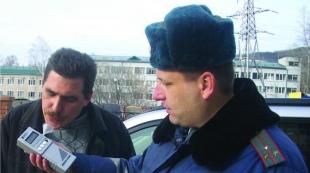Caught drunk. What happens if you get caught drunk driving
Drunkenness is one of the most serious problems of the countries located on the territory of the former USSR. Contrary to popular belief, Russia, Belarus and Ukraine are not world leaders in terms of the number of strong drinks consumed per capita per year, however, they hold positions in the top ten: respectively, the fourth, tenth and fifth places.
A person who is going to drink is aware of what he is doing and is approximately able to assess the consequences of drinking alcoholic beverages for his health.
But the drinker can no longer be responsible for his actions after taking a dose, since alcohol changes consciousness, dulls attention and increases reaction time.
The ability of a tipsy person to think critically and evaluate the likely consequences of their actions also suffers. In most cases, a drunk person considers himself completely adequate, and not those around him, and is confident in his insight and complete control over what is happening.
Due to the inability (or unwillingness) to assess the real threat to their lives, the health of others, state property and public order, a drunk motorist is quite capable of getting behind the wheel and, accordingly, causing a traffic accident.
Therefore, the legislation of the Russian Federation provides for various penalties for the offense committed, depending on its severity.
Permissible blood alcohol content
Many drivers mistakenly believe that drunk driving is only recognized as driving after taking a large dose of alcohol and, after drinking a little alcohol, get behind the wheel of a vehicle.
When stopping and checking on the breathalyzer (a device that shows the content of alcohol vapor in the air exhaled by the driver), it turns out that the motorist violated the law by driving while intoxicated.
The amount of alcohol, which, according to the letter of the law, will not affect the ability to drive a car, is indicated in article 12.8 of the Administrative Code of the Russian Federation and is:
- in the blood of a motorist - 0.35% (ppm, 1/10 percent), that is, 0.35 ml. for 1 liter;
- in the air exhaled by him - 0.16% (0.16 ml per 1 liter).
The amount of alcohol that corresponds to the figures given is small. According to elementary chemical calculations, this is about 15 grams of vodka or a standard glass of light beer, and then two or three hours before the trip.
It is also better for a driver who is going to drive a car the next morning after drinking alcohol to limit evening libations.
The rate of alcohol withdrawal from the body is individual, and depends on the following factors:
- driver's gender;
- age;
- body weight;
- general health and the presence of current diseases.
Check for alcohol intoxication
The traffic police inspector, after stopping the vehicle, with the help of the senses, preliminarily assesses the condition of the driver.
Signs of intoxication are:
- slurred or difficult speech of a person driving;
- violation of fine motor skills and general coordination of movements;
- unusual complexion;
- inappropriate behavior;
- the smell of alcohol emanating from the driver.
If the inspector noticed one or more signs, he must remove the motorist from driving and conduct an initial examination for the presence of alcohol in the blood using a breathalyzer at the stop.
medical expertise
If the initial examination shows the presence of alcohol in the blood, the traffic police inspector should ensure that the driver is taken to a mobile station or medical facility for a medical examination.
This procedure is carried out by a doctor or, in rural areas in the absence of a doctor, by a paramedic, and includes a second examination with a breathalyzer, blood sampling and urine testing.
According to the results of the tests, the doctor (or paramedic) concludes that there is retained alcohol in the blood and, accordingly, the state of alcoholic intoxication.
Drunk driving penalty
The punishment for drunk driving is assigned in any case, however, the penalty is determined taking into account two factors:
- the consequences of the misconduct (their presence or absence and the severity of the accident);
- repeatability (the driver violated the law for the first time or committed a relapse, that is, a repeated violation).
What happens if you get stopped for drunk driving for the first time
Article 12.8 of the Code of Administrative Offenses (CAO) for the first recorded offense provides for the following penalties:
- imposition of an administrative fine in the amount of 30,000 rubles;
- deprivation of the offender of the right to drive a motor vehicle for a period of 1.5 to 2 years;
- administrative arrest for a period of ten to fifteen days.
A driver who refuses to undergo a medical examination will be punished in the same way: such a refusal in itself is considered evidence of alcohol intoxication.
A person who transfers control of a motor vehicle to another person who is in a state of intoxication also risks his money and driver's license (the severity of the punishment is identical to the previous paragraphs).
The current legislation also provides for criminal liability for an offense if it was committed repeatedly or had serious consequences.
Responsibility of the driver for repeated violation
Punishment for drunk driving does not always have an educational effect on the driver, and some motorists, once having lost their rights, repeat the same offense after a while, that is, they commit a relapse.
A recidivism is an offense committed repeatedly within a year after the expiration of the period of deprivation of a driver's license or before the expiration of this period.
If a recidivist was stopped by a traffic police inspector and caught in a misdemeanor, then according to the provisions of Article 264.1 of the Criminal Code of the Russian Federation that came into force on July 1, 2015, he will face criminal liability.
Punishments for motorists who have committed a relapse:
- a fine in the amount of 200,000-300,000 rubles;
- deprivation of a driver's license for a period of 3 years;
- compulsory work with a total duration of up to 480 hours;
- forced labor for up to 2 years.
A driver who repeatedly refuses a medical examination faces exactly the same penalties, since this action also qualifies as a relapse.
Contrary to popular belief, the confiscation of a vehicle for driving under the influence of alcohol is not provided, although such an idea was expressed during the discussion of the bill.
The fine itself in the amount of 300,000 rubles is comparable to the cost of some brands of cars, which makes confiscation an unnecessarily harsh punishment.
Drunk driver hits a pedestrian
Not every case of collision is recognized as an offense.
There are two options:
- collision in a place not intended for pedestrian movement;
- collision at a regulated or unregulated pedestrian crossing.
In the first case, when it is established that the driver knocked down a pedestrian outside the pedestrian crossing zone, the motorist is found not guilty in the accident.
However, if he was intoxicated at the same time, he will have to pay an administrative fine and lose his driver's license for a specified period.
The pedestrian, in turn, will also pay a fine for crossing the road in the wrong place. According to statistics, the majority of cases of collision with pedestrians are caused by ignoring the latest traffic rules.
Also, the driver will not be punished if he knocked down a pedestrian, for one reason or another, who intentionally jumped out under a moving vehicle (for example, if the victim intended to blackmail a motorist).
If the driver drove the car sober, he will have enough testimony or the presence of a DVR recording to justify him.
A motorist who was in a state of intoxication, despite the proven guilt of a pedestrian, in accordance with the provisions in force in 2017, will have to bear an administrative penalty identical to that described above.
In the second case, regardless of the actions of the pedestrian, the driver is found guilty: the provisions of the Rules of the Road oblige the motorist to make sure that there are no pedestrians on it before crossing the pedestrian crossing.
Alcohol intoxication of the driver who committed such a collision is considered an aggravating circumstance. Accordingly, the penalty will consist of two parts: responsibility for an accident and for drunk driving.
The severity of the punishment directly depends on the severity of the damage caused to the health of the pedestrian.
The following types of traffic accidents are possible:
- The pedestrian was not injured in any way. In this case, optimal for both the pedestrian and the driver, the latter faces the standard punishment for driving while intoxicated;
- The pedestrian suffered minor injuries. According to Article 12.24 of the Administrative Code of Russia, the court in this case imposes a penalty in the form of an administrative fine in the amount of 2500-5000 rubles or deprivation of a driver's license for a period of 1 to 1.5 years. If the motorist was intoxicated at the same time, he will have to pay an additional fine of the standard size and lose his rights for 2 or (in case of relapse of the offense) 3 years;
- The pedestrian suffered moderate damage. The punishment for a motorist will be a fine in the amount of 10,000-20,000 rubles, an additional fine for drunk driving and deprivation of a driver's license for 2 or (in case of repeated violation) 3 years;
- The pedestrian was seriously injured. In this case, the driver bears not only administrative, but also criminal liability. The administrative part of the punishment includes a fine of a fixed amount and deprivation of rights for a certain period. Criminal liability consists in the appointment of forced labor up to 2 years and imprisonment (imprisonment) up to 3 years;
- Fatal collision with a pedestrian. In addition to administrative punishment, the perpetrator necessarily bears criminal liability:
- if one person died as a result of an accident - imprisonment for up to 7 years;
- if 2 or more people died - imprisonment up to 9 years or forced labor for up to 5 years.
In addition to penalties in favor of the state, the driver guilty of an accident associated with harm to the health and life of a pedestrian, in accordance with the standards in force in 2017, pays monetary compensation to the victim or, in the event of a death, to the relatives of the victim.
Deadline for payment of fines
Payment of fines imposed for the commission of traffic accidents, including when driving under the influence of alcohol, is made in the manner established by the Code of Administrative Offenses of the Russian Federation.
The prescribed payment period is 60 days from the time the offense was recorded or, in the case of a driver who was intoxicated, from the moment the doctor issued a medical report.
Federal Law of Russia No. 437-FZ of December 22, 2014 provides the driver with the opportunity to pay only half of the imposed fine, provided that the amount is paid within 20 days.
This is useful both for the state, which receives money faster, and for the motorist paying a smaller amount.
When the driver fails to pay the fine on time, information about this is transferred to the bailiffs.
The bailiff service gives the debtor the opportunity to pay the fine within 10 days, after which the following sanctions are applied:
- the amount of the fine is doubled;
- correctional labor is assigned with a total duration of up to 50 hours;
- administrative arrest for up to 15 days is applied.
To avoid sanctions and misunderstandings with bailiffs, first of all, the driver must pay a fine.
If the motorist thinks that the fine was imposed unreasonably, he has the opportunity to appeal the court decision before the expiration of 10 days from the issuance of the decision.
Can drunk driving be avoided?
A driver accused of driving while intoxicated needs to build a line of defense.
To do this, first of all, you need to familiarize yourself with copies of the documents drawn up by the traffic police inspector:
- a protocol on suspension from driving a motor vehicle;
- an act of examination for alcohol intoxication, carried out at the place of detention;
- a printout or a paper attachment to the survey report indicating the result of the examination;
- protocol on referral for a medical examination;
- protocol on an administrative offense.
- at the request of the motorist, he is also provided with copies of:
- report of the traffic police inspector;
- written testimony of attesting witnesses and, if any, witnesses.
In order to initiate proceedings on an administrative offense, the first to be drawn up, in accordance with Article 27.12 of the Code of Administrative Offenses, is a protocol on removal from driving.
In the document, the inspector must indicate the reasons for removal from control and the data of attesting witnesses. In addition, for the document to come into force, it must be signed by the traffic police officer, the detained driver and attesting witnesses.
Before signing the document, and during its further study, you should pay attention to the coincidence of the place of occurrence indicated there with the real one.
In preparing for the defense, the driver must remember the conditions under which the examination was carried out (on the street or in the inspector's car), whether witnesses were present, how far they stood and whether they could see all the stages of the procedure.
It is necessary to find out who the witnesses were - it is quite possible that the same traffic police officers acted in their role.
If possible, you need to visit the witnesses and find out if they saw everything well and how they signed the act: sometimes people are given an unfilled form to sign, into which information beneficial to the traffic police is subsequently entered.
If such facts took place, it is necessary to ask attesting witnesses to speak in court. In order to maintain good relations with them, they should be compensated for their travel expenses to the place of the process. In most cases, witnesses are ordinary people supporting the driver.
If there were no witnesses indicated in the act at the scene at all, or there is reason to believe that these are figureheads (police officers or their relatives), it is necessary to petition the court to summon these people to testify. If they really were not there, they will not be able to correctly answer the questions, which will tilt the judge's opinion to the side of the defendant.
If there is reason to assume such a turn of events, the driver must file a written petition for exclusion from the evidence base, in accordance with Part 3 of Article 26.2 of the Code of Administrative Offenses of Russia, documents drawn up in violation of the law.
The certificate of examination provides a column for entering the result of the examination in digital form.
This result must be compared with the data on the check of a portable breathalyzer: the values must match exactly. Also, both documents must contain the same time of the survey.
In addition, on paper, in accordance with paragraph 135 of the Administrative Regulations (Order of the Ministry of Internal Affairs No. 185 of March 2, 2009), the signatures of the driver and witnesses must be.
The act provides for a separate column "Agree / disagree"; it is also necessary to check its filling: whether the handwriting belongs to the driver himself, whether there is a signature of the detainee nearby. If the column says "I agree", the driver must remember whether he wrote this as a result of deception or under pressure.
If there is reason to question this document, an appropriate petition should be sent to the court to exclude the act from the evidence base.
If the motorist was sent for a medical examination, the inspector had to draw up an appropriate act.
The protocol on referral for a medical examination provides three reasons for this decision, namely:
- refusal of the driver to pass the examination;
- disagreement of the motorist with the results of the examination;
- that the inspector has good reasons to assume that the driver is intoxicated if the breathalyzer testifies negatively.
When drawing up the protocol, the inspector simply needs to emphasize the reason appropriate to the circumstances.
When examining a document, the legality of the inspector's actions should also be assessed.
For example, if the driver did not refuse to be examined at the stop, and the inspector did not conduct this, the traffic police officer had no reason to send the motorist for a medical examination, and the procedure itself was recognized as illegal and its results were not taken into account.
What you need to know about the act of medical examination
An act of medical examination for alcohol intoxication must be drawn up and certified by a doctor or, in rural areas, a paramedic.
According to the Order of the Ministry of Health No. 308 of July 14, 2003, the medical worker performing the procedure must undergo appropriate training and have a certificate.
The act indicates the date of issue of the certificate, the validity of which is 3 years. If the certificate is expired or the physician did not have it, he did not have the right to conduct a study.
The act should not contain blank columns, all corrections must be certified by the signature of a doctor or paramedic and made to the act before making a copy from it.
Repeated samples can be taken no earlier than 20 minutes after the previous ones were taken.
Attention should be paid to the identity in the act and on paper of the result of the examination and the time of its conduct.
The document should also show:
- device brand;
- availability at the time of the examination of permission for its use;
- date and circumstances of calibration and verification;
- a certificate for the device.
The line of defense should be built on the basis not of the results themselves, which are impossible to dispute in principle, but on the inconsistencies found in the papers and the violations committed during the preparation of the act.
If the driver additionally passed an independent medical examination that showed the permissible level of alcohol in the blood, he should also submit this conclusion to the court.
The next stage after the execution of the medical examination certificate is the drawing up by the traffic police inspector of a protocol on an administrative offense.
When examining a copy of the document, the accused should ask questions:
- whether the actual place of the incident is indicated in the act;
- are all witnesses, including passengers of a driver-driven car, listed in the report, if someone is missing, you need to petition to summon them to court;
- who are the witnesses indicated in the document, and whether there are traffic police officers among them;
- whether the essence of the violation is indicated (this should be clause 2.7 of the SDA);
- under which article of the Code of Administrative Offenses, in the opinion of the inspector, the committed offense falls;
- whether the explanations were written by the driver himself or the entry was made by the inspector;
- when writing an explanation, whether psychological pressure was exerted on the motorist or whether he was misled (a traffic police officer can say that only a fine is due for an offense under article 12.8 of the Code of Administrative Offenses of Russia).
It is necessary to carefully read the “Application” column and check whether copies of all the documents listed there have been issued to the motorist.
The traffic police inspector can, after the driver leaves, fill out a report or attach testimonies of other employees or fictitious witnesses to the report.
Such cases are especially common when an inspector stops a driver from a remote region or region: the court will not call a witness from the other side of the country.
You should find out in advance at what time and where (at the place of residence or at the scene of the incident) a hearing in the case is scheduled. Lateness or failure to appear at the trial will not allow the accused to defend himself and practically guarantee him a fine and deprivation of rights.
In addition to the above clues, one should recall other inconsistencies and circumstances that favor the protection of the interests of the driver.
After preparing and collecting information, it is time for the driver to start thinking through the line of defense. It is impossible to foresee all possible situations, so you need to be prepared for unexpected turns of events.
In order not to forget anything during the process, all your thoughts and arguments on the case should be written down or printed on sheets of paper.
The defendant's speech should be convincing enough and filled with self-righteousness, but not too emotional, this will create a bad impression.
Having collected and classified all the important details, you can get free (in most cases) legal advice: a professional will be able to point out additional clues and weaknesses in the defense.
Until this moment, you should not contact a lawyer, he will not be able to provide high-quality free assistance.
After examining all the documents and carefully selecting and arranging in a logical chain of arguments in their favor, the car owner can appear in court and, with a high probability, protect his driver's license.
Driving a vehicle requires skill and increased care on the part of the driver. The driver driving a car must be collected and adequate while driving, it is strictly forbidden to drive a car while intoxicated. In this article, we will talk about the consequences of drunk driving, and also find out what punishment is provided for this.
Legislation or fines
Driving under the influence of alcohol is prohibited by the current legislation. a driver who is under the influence of drugs, alcohol or toxic substances is not allowed to drive a vehicle. In case of violation of the law, the driver is subject to administrative liability for an administrative offense. Drunk driving or transferring the vehicle to another drunk person is punishable by a fine of at least $450, as well as deprivation of a driver's license for a period of 2 years.
The driver's license is taken away on the basis of a court decision. If the driver commits a second violation, the fine increases in size and amounts to $ 720, and the driver's license is taken away by court order for 3 years. If a stopped driver drives a vehicle while intoxicated, they can be arrested for 15 days with mandatory community service or have to pay a fine of $450. In the event of an emergency and the presence of injured drivers, the driver will not only be deprived of their rights, but also subject to criminal liability.
Drunk driving

If you are stopped while drunk driving, try not to show aggression and do not resist when stopped, this behavior will help in further conversation with the inspector. If you fail to control yourself and your emotions, then it is possible that a traffic inspector may:
- deprive a driver's license by court order for 2 years;
- issue a $450 fine;
- pick up the car and drive it to the impound lot.
If it already happened that you were made drunk, follow all the instructions of the inspector, answer all the questions posed and do not argue. Remember, the lack of manifestation of character, emotions and excessive not sober courage will help to avoid increasing fines in administrative and criminal violations.
For information! If you resisted driving while intoxicated, the traffic inspector has the right to apply punishment to you in accordance with the regulations “Insulting an official in the course of duty” and “Drunking while intoxicated”. In case of use of force or resistance, the inspector may use force, which is legal, as well as a fine of 50 non-taxable minimums.
At the time of detention, a protocol is drawn up with a detailed description of the violation, the driver is warned about the punishment and the vehicle is driven to a penalty parking lot. After all the procedures, the drunk driver is arrested for 15 days with the obligatory performance of community service. The detention is carried out at the station, so it will not be possible to avoid punishment and community service.
Not sober driving or how to behave with an inspector

In order to avoid more punishment, we suggest that you study the recommendations that will help you behave correctly with the inspectors. Algorithm of actions or “drunk driving what to do”:
- don't resist;
- perform all the actions that are required of you;
- answer the questions clearly;
- do not refuse to sign in the drawn up protocol;
- do not refuse to conduct an examination.
Drunk driving is a gross violation, but sometimes there are situations that force the driver to break the rules. There are situations in which you can try to get your driver's license back:
- urgent departure after taking a small amount of alcohol;
- drinking alcohol the night before, before the morning trip;
- deprivation of rights for residual alcohol intoxication;
- when detecting cannobiods in the blood.

In such a situation, experts advise hiring an experienced and professional auto lawyer who will help you understand the case, as well as find possible errors in the process of filing charges. As a rule, inspectors make mistakes that allow them to appeal the charges against them. An auto lawyer will study the case, namely:
- find errors and inaccuracies in the issued protocol;
- check technical devices that check the level of alcohol in the blood;
- perform a search for false witnesses;
- conduct a survey of witnesses, perform clarification of the details of the incident;
- in accordance with the law, will interrogate the inspector in the courtroom;
- wins the case (the auto-lawyer independently represents the interests of the accused person, so you don’t have to attend the trial itself).
For information! In practice, there are cases of returning a driver's license due to an incorrectly drawn up protocol.
If the inspector reveals suspicions about the sobriety of the driver, he has the right:
- find witnesses;
- draw up a document that removes the driver from the ability to drive a car;
- draw up an act of checking the driver for the presence of alcohol intoxication;
- upon confirmation of the violation, draw up a protocol on the detention of the vehicle, send it for a medical examination;
- send a notice to the court for deprivation of rights.
How an examination is carried out

The traffic police officer has the right to conduct an examination, which will be legal only if all the key points of the procedure are observed. The presence of a breathalyzer does not mean that a traffic officer can stop everyone in a row and check for alcohol intoxication. Alcohol testing should only be carried out if there is good reason, evidence and a strong smell of alcohol from the driver. Each reason is displayed in the protocol with the mandatory presence of signatures.
Important! Examination for the determination of alcohol is carried out after the clarification of the milestones of the rights and only in the presence of attesting witnesses. At the request of the driver, the inspector is obliged to provide a certificate of registration of the breathalyzer and the inspection.
Chasing and resisting an authorized person

From practice, there are cases when drivers driving a vehicle while intoxicated tried to hide from authorized employees. If this has already happened, do not try to hide, because. this could lead to an accident, damage to the vehicle and possible injury or death. Stop at the request of the traffic inspector should be regardless of the state. The culture of communication and courtesy will help create the impression that you are a conscious person who is able to take responsibility for your actions and deeds. Adequate behavior will definitely have a positive impact in the preparation of the protocol and in the decision of the court. When chasing and resisting, punishment is applied in the form of:
- issuance of a fine;
- withdrawal of a driver's license from 36 to 76 months;
If there are victims due to the fault of a drunk driver, criminal punishment is applied in the form of imprisonment with a term of 12 to 15 years.
At the moment, there are no people who would not be aware that drunk driving as a driver of a motor vehicle should be punished (including deprivation of rights for alcohol intoxication).
The state is constantly striving to tighten traffic rules on the roads in order to prevent the number of accidents on Russian roads and their victims, victims.
Now let's talk about the alcohol limit.
The law regulates the permissible value in the body of ethyl alcohol equal to 0.16 mg / l.
It is worth noting that this figure did not come from nowhere. The set value is the permissible error of measuring instruments (alco-testers).
Certification
There are two types of examination: examination (by an inspector) and medical examination (by a doctor).
Traffic police officer

In order to carry out this procedure, the traffic police inspector needs good reasons, but he has the right to force him to undergo an examination directly with a doctor.
A police officer checks for the content of alcohol in the body of a suspect using a breathalyzer, while he can video record.
It is important to say that the test can be refused, and without subsequent punishment.
During the on-site examination, the police officer performs the following procedure:
- if external signs of intoxication are detected, a suspension from driving a car should be performed (a protocol is drawn up in the stay of two witnesses);
- conducting an examination, taking into account a miscalculation, inaccuracy, after which an examination certificate for the state of alcoholic intoxication must be drawn up with the signatures of all those present;
- in case of disagreement with the conclusion from paragraph 2, the traffic police officer is obliged to send and accompany the perpetrator to the medical. examination in the presence of two witnesses (with the preparation of a protocol); if intoxication is not detected, the inspector must deliver the driver back to his vehicle.
doctor

Honey. workers offer to take certain tests that clearly demonstrate whether the individual is actually drunk.
Please note: in such a case, the refusal will force you to answer to the same extent as for the “drunk driving” for the first time.
Now let's study in more detail how a driver's license for alcohol intoxication can occur in 2018 for the first time.
Primary Crime Legislation

Anyone who starts driving under the influence of alcohol should be aware that they will have to answer for breaking the law.
- a person is deprived of a driver's license for a period of time lasting from 1.5 to 2 years;
- a fine, the amount of which is 30,000 rubles.
An identical punishment is also provided for individuals who provided a drunken citizen with the opportunity to manage:
- The driver is deprived of his license for a period of 1.5 to 2 years;
- A fine equal to 30,000 rubles.
So, the traffic police officer “took” your certificate. Now you are worried about two questions: what to do? how to get rights back?
I hasten to add that there is not always a deprivation of rights for alcohol intoxication, in some situations an amnesty is provided.
"Pardon"

Amnesty, of course, is not always applicable. Individuals who are not first caught in an intoxicated state may not bet on the leniency of the law, as are those who were caught under the influence of narcotic or other psychotropic drugs.
Persons who have incurred administrative responsibility for a crime of the law, and whose blood has not exceeded 0.2 mg / l of ethanol, can believe that an amnesty will be prescribed for deprivation of rights when intoxicated.
I want to note that there are some cases when the driver can think about amnesty options. In such a situation, everything depends on the severity of the offense and the conditions in which it was performed.
And if the inspector, having drawn up the protocol, made a mistake, then the return of the certificate is quite feasible. The main thing is to confirm innocence.
Participation in non-compliance with the law can be rebutted in the following cases:
- catastrophic need to drive (while drinking occurred in the evening of the previous day);
- in the human body, the remnants of alcohol can remain for a long time, for which it is impossible to deprive a driver's license;
- taking special medications that could lead to charges of drug use.
Due to the increase in the number of traffic accidents, as well as their grave consequences, it was through the fault of drunk drivers that more substantial measures were taken to return the driver's license to its owner.
Now drivers who have already lost their rights once are not waiting for an amnesty, but for passing tests (exams) according to the rules of the road. It can be noted that this method of solving the problem turned out to be, in fact, effective. As funny as it may sound, citizens are gradually realizing that it is better not to drive drunk.
Secondary crime legislation

- write out a fine in the range from 200,000 to 300,000 rubles;
- repeated deprivation of rights for up to 3 years; Performing social work (up to 480 hours);
- imprisonment of a citizen (up to 2 years).
When drunk driving is repeatedly revoked, the question of measures to influence a citizen is dealt with by a judge.
Penalty for drunk driving resulting in an accident or death:
- the insurance company has sufficient authority to refuse to restore the car;
- deprivation of a driver's license for a period of up to 3 years;
- when causing light or medium damage to the health of a traffic participant within the road, the driver is held administratively liable (fine);
- criminal liability begins (up to 4 years) when a person has been seriously harmed;
- one person died during the incident - for a citizen, imprisonment for a period of 2 to 7 years is provided;
- if the incident was not limited to one dead, then the sentence will be different - from 5 to 9 years.
In all cases, when a drunk driver is driving, his vehicle is delayed, which implies that the inspector has the right to deprive the driver of the possibility of further movement, and the motor vehicle itself is transferred to the parking lot intended for this.
At this time, the perpetrator undertakes to pay for the services of a tow truck and the time the car stays at the impound lot.
However, extra costs can be avoided. Transport does not need to be evacuated if the reason for the detention has been eliminated.
If you have a friend, brother, sister or just an acquaintance who has rights, you can trust such a person to deliver the car to the parking lot or garage. With the condition that this person is recorded in the OSAGO policy (or the insurance is not limited).
How to get away from punishment?

You were suspended by a traffic police officer and offered to be tested for the level, so to speak, of “drunkenness”.
Is it possible to avoid the revocation of the rights for driving under the influence?
Yes. And any defect or blot of the inspector will be able to help you out in the future, because the smallest mistake already becomes the basis for a protest.
This begs the question: how to avoid deprivation of rights for alcohol intoxication?
You have the right to make an audio or video recording of the actions taken by the inspector. It will not be superfluous to both record the dialogue on a voice recorder and film what is happening on camera. Before signing the protocol, carefully check whether all comments and remarks have been made. In no case do not rush.
Often, when a traffic police officer prepares a protocol, the facts indicated by him can save the driver. You should not rely on the location of a police officer and admit that you drank a little.
Sincere confession in the use of alcohol will be the deepest mistake. Carefully look at the device that you are offered for testing: study the technical specifications, serviceability and quality certificate of the device.
Sometimes, in order to achieve this or that result, traffic police officers use faulty breathalyzers.
In conclusion, you need to draw up a paper, stipulating in which:
- whether the presence of a traffic police inspector at the post is legitimate;
- whether eyewitnesses were interviewed;
- whether the examination was carried out correctly.
If the judge ruled absolutely not in your direction, then there is a chance to file an appeal within 10 days.
What to do if you are falsely accused?

In any independent drug treatment clinic, you can take tests, which will be the most rational way out.
Upon receipt of a medical certificate, a citizen will be able to verify that he is right by seeing the numerical value of the alcohol content in the blood. The best option would be to conduct two independent examinations at once, so the chance to win in court will increase.
The examination should be carried out within two hours after the honey. examinations.
An appeal against the punishment will only be successful if the police officer acted unlawfully towards the accused, so it is necessary to present real evidence based on facts. For example, an audio recording on a dictaphone, testimony of witnesses.
Then an application is drawn up with a request to replace the deprivation of a driver's license with a fine, this application is submitted to the court.
Now there is an opportunity to challenge the protocol of the traffic police inspector.
Due to various life circumstances, many of us drive almost all the time. At the same time, drugs, alcohol and many drugs are absolutely incompatible with driving.
Article 12.8 of the Code of Administrative Offenses of the Russian Federation is no less strict towards citizens and guests of the country than other criminal
part 1. Driving a vehicle by a driver in a state of intoxication, if such actions do not contain a criminally punishable act, -
part 2. Transferring control of a transport vehicle to a person who is in a state of intoxication -shall entail the imposition of an administrative fine in the amount of thirty thousand rubles with deprivation of the right to drive transport vehicles for a term of one and a half to two years.
part 3. Driving a transport vehicle by a driver who is in a state of intoxication and does not have the right to drive transport vehicles, or who has been deprived of the right to drive transport vehicles, if such actions do not contain a criminally punishable act -shall entail administrative arrest for a term of ten to fifteen days or the imposition of an administrative fine on persons in respect of whom, in accordance with this Code, administrative arrest may not be applied in the amount of thirty thousand rubles
But in this law, as in any other, there are nuances that can save the situation or make it worse.
Permissible ppm
Today, according to the law, in the blood of the driver there can be no more than 0.16 milligrams / liter of exhaled air. In practice, this means that when traveling in Russia, unlike in Europe or, for example, America, you can’t drink at all. An inexpensive breathalyzer has an error of 0.05, i.e. 0.16 - a threefold error of an inexpensive breathalyzer. In other words, police officers often have low-quality instruments at their disposal, the error of which is up to 0.05 units. In addition, the driver may take medications containing alcohol. Taken into account when adopting the law and a long period of excretion of alcohol from the body. So, cognac, the strength of which is 42%, can be excreted from the body for 30 or more hours. The rate of excretion depends on weight and health status. Thus, drinking a bottle on Sunday can prevent you from driving to work on Monday in your own car.
Established by law, the rate of 0.16 ppm is approximately 33 grams. vodka. But much will depend on the amount of food eaten and individual factors, which have already been mentioned above - the weight and condition of the body. And if an error of 0.05 is included in the calculation, it becomes clear that drivers can drink only on days when the use of a personal car is not planned. True, light drinks are excreted from the body quickly, of course, with moderate use. So, a drunk bottle of weak beer will quite allow you to drive in a couple of hours, but even 100 gr. a relatively light cocktail, the strength of which is about 9%, will give much more than the required norm of alcohol in the blood, if you drive immediately after drinking. The verdict is harsh: driving under the influence of alcohol in the Russian Federation, even a very small one, will lead to deprivation of rights for a long time.
Stopped drunk driving: what is the procedure?
If a law enforcement officer suspects that the driver is drunk, then, according to departmental instructions, he is obliged to remove him from driving and send him for a medical examination. To prevent the car from getting into the impound, it can be transferred to a relative or friend who has a driver's license and a power of attorney from the owner. In more detail, this procedure is written in paragraph No. 13 of the Rules for Detaining a Vehicle.
Next, the driver is sent for a medical examination. If the examination establishes an excess of the norm, it will be impossible to return the rights earlier than in 1.5 years. Before sending, the traffic police officer must draw up a protocol and give a copy to the driver. After the examination, a protocol must also be drawn up. Medical examination may be waived. But in order for the refusal of a medical examination not to turn into a guilty verdict in court, it will be necessary to pass an examination within 2 hours in any licensed institution that has permission for this activity, and also to justify in court the impossibility of passing an examination immediately at the request of a traffic police officer. True, witnesses will have to assure the refusal. If a traffic police officer exceeds his authority or you feel insecure, then you should resort to the help of a lawyer. Fortunately, 24/7 legal advice is available to everyone in the age of cell phones.
Transfer of the vehicle to a third person who is in a state of intoxication
The mechanism for the transfer of funds is not reflected in the code. Also, the topic of how the owner of a vehicle or a person using a car by proxy can and should determine the condition of a person who was stopped drunk is not disclosed. In fact, all this is left to the discretion of the court, which must, in honor and conscience, make a decision, therefore, not only actions, but also the glory said for the record will matter.
In order to be held liable under Art. 12.8, clause 2, it will be necessary to prove the fact of the transfer of transport voluntarily, as well as the fact that the person who transferred was knowingly aware of the state of intoxication of the one to whom control was transferred. If the principal and / or car owner was not near the drunk driver at the time of detention, then it will not be easy to prove guilt. The degree of intoxication also matters. The lower the milligrams in the blood, the more difficult it is to prove that the owner/principal knew that the driver was driving drunk. In other words, if you don't confess yourself, you won't be guilty.
Recently, the traffic police are increasingly arranging checks for alcohol intoxication of drivers. This is due to the fact that an accident due to a drunk person driving is not uncommon on the roads. And not only the driver suffers, but also the people around. But if a person who has never violated and never received such a fine, suddenly, for some reason, got behind the wheel after a bottle of beer, and he was caught drunk driving, what awaits him? What are the actions of the authorized bodies during the inspection and examination and what punishment threatens the violator who is caught drunk for the first or second time?
How is drunkenness diagnosed?
Intoxication is a violation of the physiological functions of the body and, above all, its central nervous system due to the intake of alcohol or drugs. To find out if a person has taken anything, a medical examination is carried out. Medical examination - the study and assessment of the health and physical condition of a person. A medical examination for intoxication is a procedure carried out to find out if alcohol is present in the blood of a person who has driven a car. It can be carried out both by a law enforcement officer (traffic police, PPS), and by medical workers in a healthcare facility.
Reasons for holding:
- Specific odor from the mouth.
- Incoherent speech.
- Redness of the face, which is characteristic of a drunk person.
- Loss of coordination and unsteadiness in movement.
Alcohol intoxication is determined taking into account the error - the concentration of absolute ethyl alcohol in the exhaled air must exceed 0.16 milligrams per liter.
It is necessary to take into account the fact that the tester can show the presence of alcohol, even if the person did not drink alcohol. This may be the case when taking certain medications (you must carefully read the instructions before taking it), if a person drank kvass or kefir. It is possible to get a fine without the fact of a moderate violation of the law.
Drunk driving punishment
The punishment for a person who got drunk behind the wheel can be different, it depends on some conditions. In this regard, we consider several typical situations.
If a car gets into an accident, the driver of which got behind the wheel with alcohol in the blood, the insurance company will not pay for the repair of the car, since this is not an insured event.
Punishment
 Those who are caught driving without the right to drive a vehicle, regardless of the reason for their absence (deprived of them or not receiving them at all), face administrative arrest until the fact of having a driver’s license is clarified, and after that - a fine of 3,000 rubles if the driver’s license been forgotten or lost; 15,000 rubles, when a person had no rights at all. If the arrest cannot be applied, a fine of 50 thousand rubles will be imposed.
Those who are caught driving without the right to drive a vehicle, regardless of the reason for their absence (deprived of them or not receiving them at all), face administrative arrest until the fact of having a driver’s license is clarified, and after that - a fine of 3,000 rubles if the driver’s license been forgotten or lost; 15,000 rubles, when a person had no rights at all. If the arrest cannot be applied, a fine of 50 thousand rubles will be imposed.
Also, deprivation of detention or forced labor is waiting for the owners of cars who refused a medical examination twice in a row. If the driver, who got behind the wheel drunk and does not have a license, became the perpetrators of the accident, he definitely will not be able to escape criminal liability.
If the owner of the car drank and, in order not to drive drunk himself, transferred control to another person who does not have a license, and he got behind the wheel and got caught by the traffic police, the car will go to a car impound, the owner will have to pay a fine, the amount of which is 30 thousand. rub., and to a friend - 15 thousand rubles. If he transferred control to a person who is in a state of intoxication, both of them face deprivation of their rights, fines and, in some cases, criminal punishment. In the case when the driver transferred the right to drive a car to a person without a license or to a drunk person, and he became the culprit of an accident, both of them face criminal punishment, as well as deprivation of a certificate, because. transfer of control to another person does not relieve from liability. There are times when the owner says that he did not transfer control, and the person got behind the wheel with the desire to steal, then the first one can get off punishment, but the second one will go to jail under several articles at once. 
Other features of punishment
- The violation is assigned the status “repeatedly” if the driver got behind the wheel drunk and got caught less than a year after the return of the rights after the previous deprivation.
- If the driver fled the scene of an accident, he is automatically recognized as drunk, and he will be punished in the form of deprivation of rights, and even freedom.
- The same applies to those who were sober before being stopped by the traffic police, but drank after the documents were checked and the test was carried out.
- When law enforcement officers come across a person who has previously been deprived of his license for drunk driving, and now refuses to undergo a medical examination, the situation is equated to “drunk driving” and the driver faces the same punishment as for the second time drunk driving - criminal punishment, disqualification and fines.
- If the driver is caught by the traffic police, the tester shows that he was drinking, but the person claims otherwise, the test can be re-tested or he can be sent to a medical facility for examination there. This option helps if the driver did not actually drink, but ppm appeared as a result of taking any medications or drinks based on fermentation products. At the same time, the transfer of the driver to honey. establishment is carried out by a law enforcement officer.
If you are caught drunk driving at least for the first time, at least again, a person does not need to try to avoid responsibility, it is better to lose your license for a while and remember the lesson for life than to try to leave the traffic police, give a bribe or get into an accident and go to jail.









